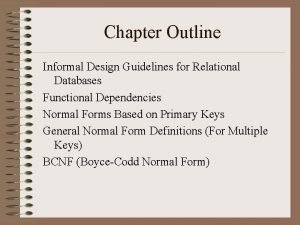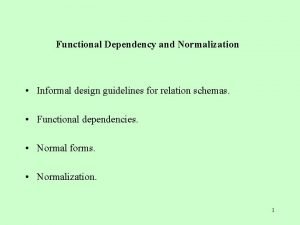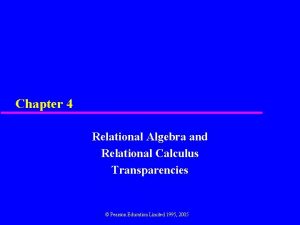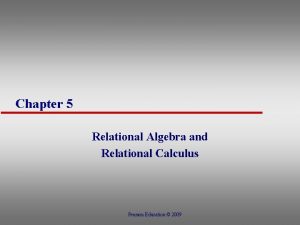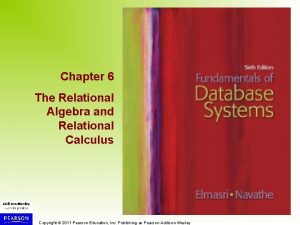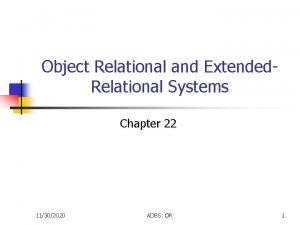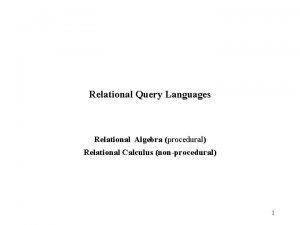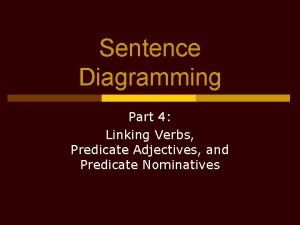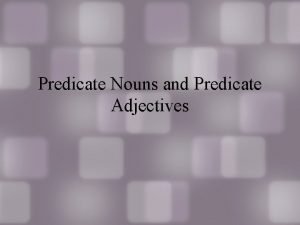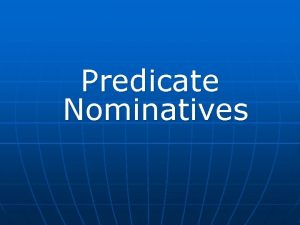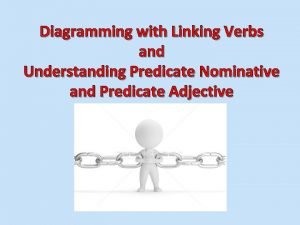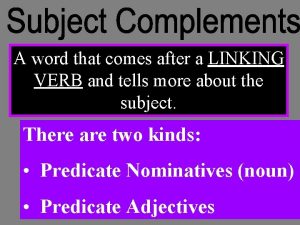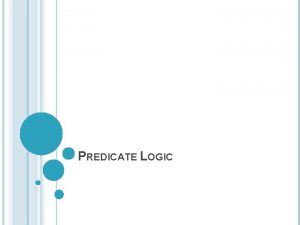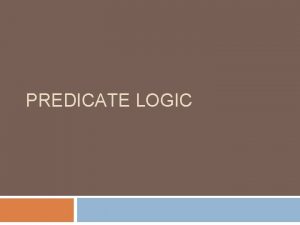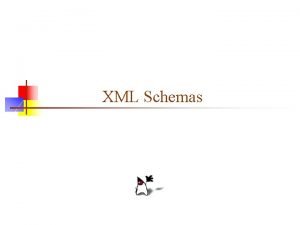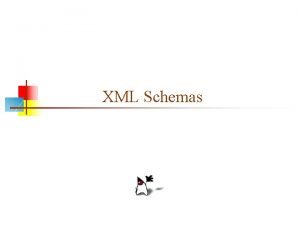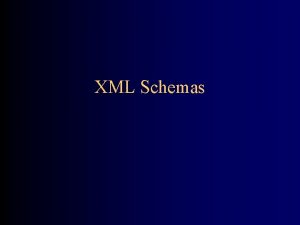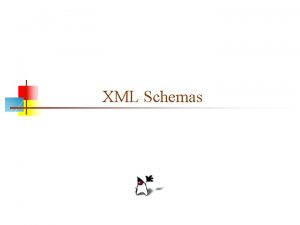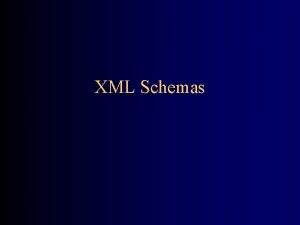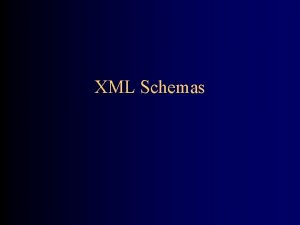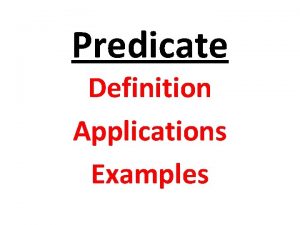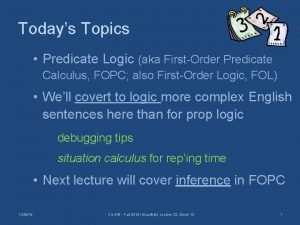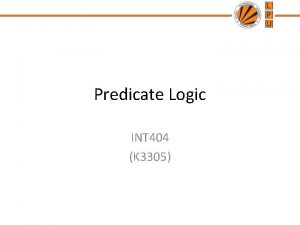Relational Schemas and Predicate Logic Notation Relations Let












- Slides: 12

Relational Schemas and Predicate Logic: Notation

Relations • Let E 1, . . , En be sets of entities or objects (we may have Ei = Ej). • The Cartesian product E 1 x … x En is the set of tuples of the form (e 1, . . , en) where ei is in set Ei. • A relation R on E 1, . . , En is a subset of the Cartesian product E 1 x … x En. We say that n is the arity of the relation. Note that a relation may be unary.

Relational Schemas • A schema specifies a finite set of relations R 1, . . Rn with additional structure: • Each column/field in a relation gets a name (can also just use position) and a domain. • A subset of fields is identified as the key. • The non-key fields are often called (descriptive) attributes. The values of the attributes are determined by the values of the key field. • Common Notation – Student(Name: string, GPA: numeric, Age: integer) – Registered(Name: string, Course: string, grade: nume

name ssn ER Model: Entities lot Employees • Entity: Real-world object distinguishable from other objects. An entity is described (in DB) using a set of attributes. • Entity Set: A collection of similar entities. E. g. , all employees. – – All entities in an entity set have the same set of attributes. Each entity set has a key. Each attribute has a domain. A key defines the values of attributes---the attributes are functions of the keys.

name ER Model: Relationships ssn lot Employees dname did Works_In lot Employees since name ssn budget Departments supervisor subordinate Reports_To • Relationship: Association among two or more entities. E. g. , Attishoo works in Pharmacy department. • Relationship Set: Collection of similar relationships. – An n-ary relationship set R relates n entity sets E 1. . . En; each relationship in R involves entities e 1, . . . , en • Same entity set could participate in different relationship sets, or in different “roles” in same set.

Notes on ER relationships • Note that relationships can have descriptive attributes too. • The values of the descriptive attributes are determined once we have identified the entities involved: grade(Joe, CMPT 354). • The fields that identify the entities involved are callled foreign key pointers.

Relational Instance and Finite Models • A relational instance is a relational schema + set of tuples specified for each relation. • The list <R 1, . . , Rn> of relations (with tuples specified, but without field names and key constraints) is called a finite model in logic.

Graphical Visualization • A graph on set S is a binary symmetic relation over S x S. • If the relation instance contains only one binary symmetric relation, it can be visualized as a graph whose edges and nodes are annotated with the values of descriptive attributes. • Classic social network analysis considers only the graph structure, not the attributes.

Translating Schemas Into Logic: no functions • Each relation of arity n predicate symbol with n arguments. • E. g. , “A student with GPA 3. 0 is younger than 40” Student(S, G, A) AND G = 3. 0 A < 40. • Pros: – Simple Translation. – Simple logic. • Cons: – Loses information about key fields. – Not always natural to read.

Translating Schemas Into Logic: Functions • Introduce one function symbol for each descriptive attribute. The arguments are the key fields. • E. g. , Age(S), grade(S, C). Also: S. age, Registered. grade. • E. g. , “A student with GPA 3. 0 is younger than 40” GPA(S) = 3. 0 Age(S) < 40. • Pros: – Keeps information about keys and foreign keys. – Natural to read. • Cons: a bit more complex mathematically.

Formal definitions in logic • Use the function-free formulation, with predicate symbols R 1, . . , Rn. • The language contains a set of constants and variables. • A term is a constant or a variable. • An atom is: – a predicate symbol with the required numbers of terms, e. g. Student(N, G, 40), Student(Jack, 3. 0, 40). – A comparison of terms, e. g. X > 3, X = Y, 5 > 1. • A literal is an atom or a negated atom.

Clauses • A clause is a set of literals. • The negated literals are called the body, the positive ones the head. • A clause is often written in implication form: b 1 AND b 2 h 1. • Also h 1 : - b 1, b 2. • A clause with a single positive literal is a Horn clause.
 Informal design guidelines
Informal design guidelines Informal design guidelines
Informal design guidelines John 10:22-28
John 10:22-28 The limited tuple relational calculus equals:
The limited tuple relational calculus equals: Relational calculus
Relational calculus Relational algebra and relational calculus
Relational algebra and relational calculus Object relational and extended relational databases
Object relational and extended relational databases Relational algebra and calculus
Relational algebra and calculus Linking verbs predicate adjectives and predicate nouns
Linking verbs predicate adjectives and predicate nouns Predicate noun examples
Predicate noun examples Predicate nominative and predicate adjective
Predicate nominative and predicate adjective How to diagram predicate nominatives
How to diagram predicate nominatives Predicate nominative examples
Predicate nominative examples
